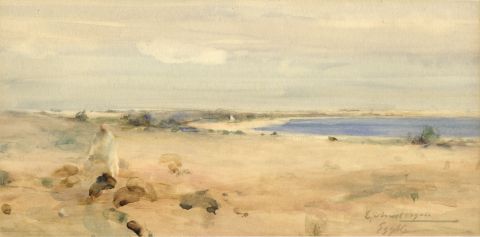This website uses cookies to ensure you get the best experience on our website. Learn more.
Erskine Edward Nicol Junior, Egypt Sands – Original 1905 watercolour painting
An original 1905 watercolour painting, Erskine Edward Nicol Junior, Egypt Sands.
This gorgeous watercolour is a rare example of the work of Erskine Edward Nicol (1868–1926), who had connections with 'The Glasgow Boys' and whose work recalls the North African subjects of Scottish painter Arthur Melville (1855–1904). The painting has a wonderfully ethereal and translucent quality which captures the brilliant light and colour of Egypt's desert sands.
On watercolour board.
All artworks come with a Certificate of Authenticity and—if it is a collection artwork—its accompanying collection text or artist biography.
Details
Signed: Signed lower right.
Inscribed: Inscribed lower right: 'Egypt' and verso 'nr/6'.
Dated: Dated lower right.
Condition: Overall in very good condition for its age. There are a couple of tiny spots of foxing in the sky. Around the periphery of the verso of the board there are paper and glue remnants from what was presumably historic backing or mounting, which do not affect the front. Some age toning to the verso. Please see photos for detail.
Presented: Unframed.
Erskine Edward Nicol was the son of Scottish artist Erskine Nicol RSA ARA (1825–1904), a successful painter of figurative, landscape and genre subjects, whose works are in the British Museum, Tate, National Galleries of Scotland and National Gallery of Ireland among others. Nicol Junior was born in London, his father having worked previously in both Edinburgh and Dublin. In 1892 and 1896 Nicol Junior made two extended visits to Egypt with the Scottish artist Edwin John Alexander RA RWS RSW (1870–1926), son of the animal painter Robert Alexander RSA RSW (1840–1923). Edwin Alexander was enamoured with the country and lived on a houseboat on the Nile for four years—the young Erskine Nicol no doubt developed his interest in the country at this time too. In the late 1880s Edwin Alexander had travelled in Morocco with his father and the Scottish painter Joseph Crawhall (1861–1913), who had a profound influence on his own style. It is likely that, in turn, Erskine Nicol was influenced by the style of his friend Edwin, and the work of the wider Glasgow artists more generally. The so-called Glasgow Boys were a group of artists painting at the turn of the 19th and 20th centuries, whose work represents the beginning of modernism in Scotland. Disillusioned with academic painting, they preferred to work directly from their subjects outdoors, and their work incorporated elements of Impressionism, the flattened forms of Japanese prints, and bold and vigorous handling of paint. Many of the artists travelled abroad, seeking influences of the exotic and the decorative; Arthur Melville (who was closely associated with the group) focused on North Africa in particular, including Egypt. Erskine Nicol married the amateur artist Cecilia Marion Frere, with whom he had one daughter, Mary, born at Trevor Square, Knightsbridge in 1913. The young family travelled widely and lived in numerous locations, in the United States, Italy, France and Egypt, where Erskine painted watercolours to be brought back and sold in England. Mary Nicol (later Leakey) began to develop an enthusiasm for Egyptology during these travels. She would go on to become a celebrated archaeologist and paleoanthropologist, who first discovered evidence of early human life in the Rift Valley of East Africa.



